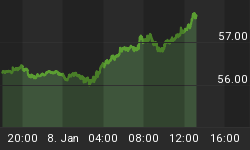In a normal economic cycle, we would be at the sweet spot of a spreading global upturn, with increased capital spending on top of revived consumer expenditures requiring a modest upturn in interest rates to sustain a balanced upturn.
That is the way Wall Street still tries to spin it to the public. But the reality, as we all know, is vastly different. This upturn was not a healthy one: the excesses of the bubble era were never properly purged, they were transferred to the housing market, to China and the whole of the financial system has become dangerously addicted to debt and the leveraged carry trade. All these factors are in the process of change.
We are facing an increasing unstable geopolitical scene - especially in the Middle East and with respect to the availability of oil. There are elements here reminiscent of the end of the Shah's regime in 1979 and all that entailed for the oil markets.
I might also note in passing that relations between the Bush administration and Iran are deteriorating again. Iran is keeping its options open about Iraq in the months ahead.
Oil prices at $40 barrel obviously carry a hefty risk premium over the supply/demand balance in normal times. The market is willing to pay this premium as insurance against a reduction in oil flows from damage to the oil infrastructure or blockage of the shipping lanes.
The possibilities of something going wrong cannot be estimated on any reasonable criteria but, if they do go wrong, then oil could spike much higher, say $60 or more. Indeed, to reach the $40 they reached in 1980 in real terms they would have to reach $100 a barrel. Now western economies are less than half as energy intensive as they were in 1980 so today's prices are an inconvenience but only likely to damp growth slightly - say 0.5 percent - over what they would have been otherwise. The higher prices go the more impact there will be and the impact will not be uniformly spread. It would have a real cooling effect.
I believe that the overall macroeconomic conditions are taking on more and more similarities with the stag-flationary 1970s but with greatly enhanced geopolitical concerns and with far greater systemic financial leverage.
In 1971-3 we had wage and price controls, the end of the Bretton Woods system, recession induced budget deficits and Arthur Burns, the supposed wise man of the time at the Fed, pumping up the money supply and artificially low interest rates. Except for wage and price controls it all sounds so very familiar.
The result of this policy was a pre-election boom with Nixon being re-elected, despite the looming Watergate scandal. Oil prices exploded before the election but got a turbo-charge from the 1973 Middle East war and the resulting embargo. The world was then set on an extremely volatile and stagflationary period with subnormal growth rates and double digit inflation rates leading eventually to the Iranian oil crisis, the appointment of Paul Volker and the election of Thatcher and Reagan.
Where are we today?
The Money supply M3 has been growing at 11.8 percent since February and over 8 percent since December. Now obviously, that rate could be reversed but it is interesting to note that it is similar to the rate set in 1972-3 which led to the 9+ percent inflation in 1974-80. The Fed funds rate is 1% and will undoubtedly be raised on 30 June. My guess is Greenspan will raise it the minimum 25 basis points since he does not want to be accused of sinking another Bush's chances of re-election.
However, the Fed is already way behind the curve. In May, even the lamentable CPI, which badly measures the prices of things we do not consume and fails to measure the prices of things we do consume, increased by 0.6 percent a 7.2 percent annualised rate. The much delayed, and presumably massaged, PPI figure came in at 0.8 percent - almost a double digit annualised rate.
So despite the best spin efforts of Wall Street and the Administration, commodity and oil price inflation is coming back. What is missing at this point for a full 1970s scenario in the US is sustained wage inflation, largely because the job market is not at healthy as painted. (Labour force participation is under 66 percent and well below the level when Bush took office. It is almost 75 percent in the UK.) If the US job figures prove to be real, which I doubt, then wage inflation will follow.
With the oil threats and the Fed behind the curve, the bond markets are still vulnerable. If bonds are vulnerable, then so are equities. An external event could trigger massive problems in derivatives. There are very real concerns about the mortgage agencies Fannie Mae and Freddie Mac with their huge opaque derivatives books. Greenspan and Snow seem to have been getting their denials in first. Not my fault, guv!
I have not mentioned the problem of China. There is a bubble in Beijing and Shanghai and the government is concerned to rein in the economy in and has been taking administrative measures, rather than fiscal and monetary ones, to slow the economy to a sustainable rate. My guess is they will keep increasing the pressure until they get results. That could mean a slowing of the economy from its present rate of 11 percent or more to one of 5 percent at the bottom. That will feel like a cold draft at some point and will have an impact on the East Asian region which has come increasingly dependent on China.
What is the net impact of all this uncertainty? In the short run, probably an increased liquidity preference, and increased volatility as markets try and adjust to a further unwinding of the leveraged carry trade.
















